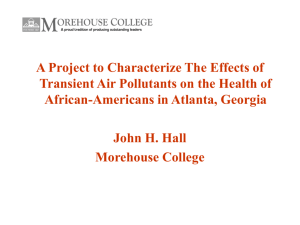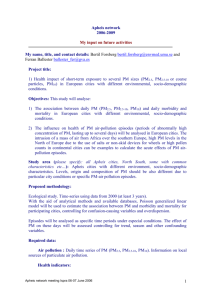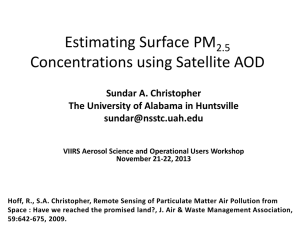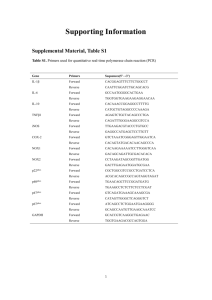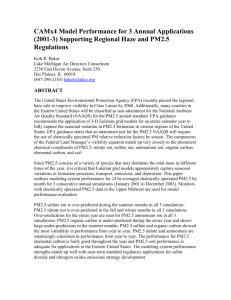Urban impacts on regional background carbonaceous aerosols in
advertisement
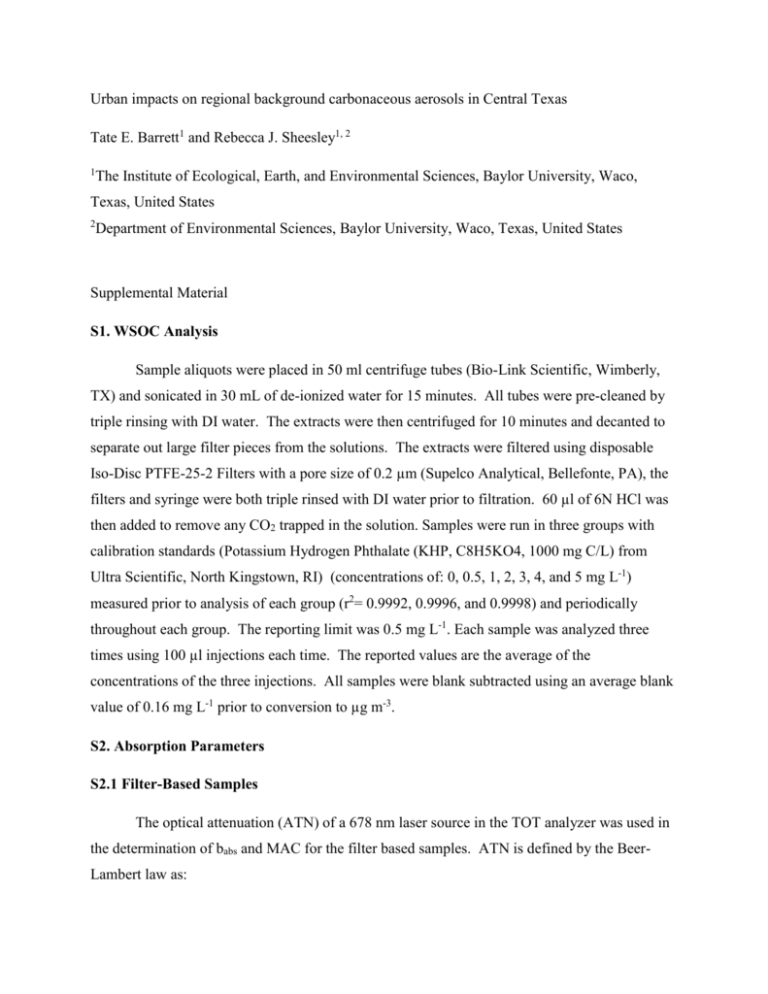
Urban impacts on regional background carbonaceous aerosols in Central Texas Tate E. Barrett1 and Rebecca J. Sheesley1, 2 1 The Institute of Ecological, Earth, and Environmental Sciences, Baylor University, Waco, Texas, United States 2 Department of Environmental Sciences, Baylor University, Waco, Texas, United States Supplemental Material S1. WSOC Analysis Sample aliquots were placed in 50 ml centrifuge tubes (Bio-Link Scientific, Wimberly, TX) and sonicated in 30 mL of de-ionized water for 15 minutes. All tubes were pre-cleaned by triple rinsing with DI water. The extracts were then centrifuged for 10 minutes and decanted to separate out large filter pieces from the solutions. The extracts were filtered using disposable Iso-Disc PTFE-25-2 Filters with a pore size of 0.2 µm (Supelco Analytical, Bellefonte, PA), the filters and syringe were both triple rinsed with DI water prior to filtration. 60 µl of 6N HCl was then added to remove any CO2 trapped in the solution. Samples were run in three groups with calibration standards (Potassium Hydrogen Phthalate (KHP, C8H5KO4, 1000 mg C/L) from Ultra Scientific, North Kingstown, RI) (concentrations of: 0, 0.5, 1, 2, 3, 4, and 5 mg L-1) measured prior to analysis of each group (r2= 0.9992, 0.9996, and 0.9998) and periodically throughout each group. The reporting limit was 0.5 mg L-1. Each sample was analyzed three times using 100 µl injections each time. The reported values are the average of the concentrations of the three injections. All samples were blank subtracted using an average blank value of 0.16 mg L-1 prior to conversion to µg m-3. S2. Absorption Parameters S2.1 Filter-Based Samples The optical attenuation (ATN) of a 678 nm laser source in the TOT analyzer was used in the determination of babs and MAC for the filter based samples. ATN is defined by the BeerLambert law as: 𝐼 𝐴𝑇𝑁 = −𝑙𝑛 ( 𝐼0 ) (1) where I0 and I are the transmittance signals before and after thermal optical analysis. ATN from the carbon analyzer is then used to determine babs: 𝐴 𝑏𝑎𝑏𝑠 (𝑀𝑚−1 ) = 𝐴𝑇𝑁 × 𝑉 (2) where A is the filter area with particle loading (mm2) and V is the volume of air sampled (m3). MAC is then calculated as: 𝑀𝐴𝐶 (𝑚2 ⁄𝑔) = 𝐴𝑇𝑁×𝐴 1 𝐸𝐶×𝑉 3.6 (3) where ECs is the filter loading of EC. All MAC calculations in this study have been corrected by an empirical correction factor, C= 3.6 (Weingartner et al. 2003). Previous studies have shown equivalence in ATN as determined by the Aethalometer and the carbon analyzer when the wavelength is kept constant (Ram and Sarin 2009; Cheng et al. 2011). S2.2 WSOC Absorption Light absorption of the aqueous extracts was measured for 200 to 700 nm on an Agilent 8453 UV-Vis spectrometer (Santa Clara, CA), with deuterium and tungsten halogen light sources. Light absorption of the extracts is defined by Beer-Lambert as: 𝐼 𝐴𝑇𝑁𝜆 = −𝑙𝑜𝑔10 (𝐼 ) = 𝐿 × ∑𝑖(𝐶𝑖 × 𝜀𝑖,𝜆 ) 0 (4) where I0 and I are the intensity of the incident and transmitted light, L is the absorbing path length, Ci is the concentration of light absorbing substances in solution, and εi,λ is the wavelength dependent mass absorption efficiency. The absorption coefficient (babs) is then calculated from ATN using the following equation: 𝑉 (𝑏𝑎𝑏𝑠 )𝜆 = (𝐴𝑇𝑁𝜆 − 𝐴𝑇𝑁700 ) × 𝑤 × ln(10) 𝑉×𝐿 (5) where Vw is the volume of water used for the extraction (30 ml), V is the volume of air sampled (m3) and L is the path length (0.01 m). Since there is no absorption for ambient aerosol extracts at 700 nm, ATN700 accounts for baseline drift during analysis (Hecobian et al. 2010; Cheng et al. 2011). Mass absorption efficiency at a particular wavelength (MAEλ) is then calculated as: 𝑀𝐴𝐸𝜆 = (𝑏𝑎𝑏𝑠 )𝜆 𝑊𝑆𝑂𝐶 (6) S.3. Geographic Source Assessment By combining ambient concentrations with BT clusters, it can be determined whether PM components (OC, EC, WSOC and PM2.5) follow any geographical source region patterns. The geographic source assessment (GSA) technique used by Sheesley et al., was used to determine contribution of PM components from each cluster (Sheesley et al. 2012). The GSA is calculated as the mean PM components weighted by the fraction of air coming from a certain cluster and the duration of the sampling. Unpaired one-sided t-tests were made to test whether the mean concentrations calculated for each source region were significantly different than the total mean values for PM components (Table S1). Table S1: Results from Geographic Source Assessment (GSA) calculations for organic carbon (OC), elemental carbon (EC), particulate matter 2.5 (PM2.5), and water soluble organic carbon (WSOC) for each cluster. P-values (to test the hypothesis that the cluster means are different from the overall means) are shown in () with bold values indicating significance. Cluster Long Range Central Plains Regional North Texas Coast Regional South GSA OC (µg/m3) (p-value) 2.15 (0.14) 2.45 (0.26) 2.04 (0.11) 2.33 (0.12) GSA EC (µg/m3) (p-value) 0.16 (0.38) 0.18 (0.31) 0.15 (0.21) 0.13 (0.002) GSA PM2.5 (µg/m3) (p-value) 5.90 (0.04) GSA WSOC (µg/m3) (p-value) 1.30 (0.11) 6.87 (0.10) 1.61 (0.32) 9.77 (0.35) 1.34 (0.15) 8.53 (0.21) 1.52 (0.17) Avg. concentration (g m-3) 5 4 3 2 1 0 2005 2006 2007 2008 2009 2010 2011 2012 Year OC TOT EC TOT OC TOR EC TOR Figure S1: Average organic carbon (OC) and elemental carbon (EC) concentrations using thermal optical transmittance (TOT) and thermal optical reflectance (TOR) methods for the Houston Clinton monitoring site. Avg. concentration (g m-3) 4 3 2 1 20 12 20 11 20 10 Ja n.Ma rch 20 ) 09 (A pr. -D ec .) 20 09 ( OC TOT EC TOT OC TOR EC TOR 20 08 20 07 20 06 0 Year Figure S2: Average organic carbon (OC) and elemental carbon (EC) concentrations using thermal optical transmittance (TOT) and thermal optical reflectance (TOR) methods for the Dallas Hinton monitoring site. Waco (Mazanec) PM2.5 (ug/m3) 30 20 10 r ²0.55 0 0 5 10 15 20 25 30 35 Riesel PM2.5 (ug/m3) Figure S3: Comparison of fine particulate matter (PM2.5) mass concentrations at the Waco (Mazanec) monitoring station and the Riesel, TX sampling location. 12 12 Houston-Clinton 10 10 8 8 OC (g m-3) -3 Sulfate (g m ) Houston-Clinton 6 6 4 4 2 2 r ²0.32 r ²0.39 0 0 0 5 10 15 20 25 30 35 0 5 10 -3 15 20 25 30 35 PM2.5 (g m-3) PM2.5 (g m ) Figure S4: Regression analysis of sulfate vs. fine particulate matter (PM2.5) and organic carbon (OC) vs. PM2.5 for Houston Clinton. 14 14 Dallas-Hinton 12 12 10 10 -3 OC (g m ) -3 Sulfate (g m ) Dallas-Hinton 8 6 4 8 6 4 2 2 r ²0.57 r ²0.36 0 0 0 5 10 15 -3 PM2.5 (g m ) 20 25 0 5 10 15 20 25 -3 PM2.5 (g m ) Figure S5: Regression analysis for sulfate vs. fine particulate matter (PM2.5) and organic carbon (OC) vs. PM2.5 for Dallas Hinton. Dallas-Hinton -3 Sulfate+Nitrate+Ammonium+OM+EC (g m ) 25 20 15 10 5 r ²0.65 0 0 5 10 15 20 25 -3 25 -3 Sulfate+Nitrate+Ammonium+OM+EC (g m ) PM2.5 (g m ) Houston-Clinton 20 15 10 5 r ²0.65 0 0 5 10 15 20 25 30 35 -3 PM2.5 (g m ) Figure S6: Regression analysis of sum of sulfate, nitrate, ammonium, organic matter (OM), and elemental carbon (EC) vs. fine particulate matter (PM2.5) for Dallas Hinton and Houston Clinton sites. 12 Riesel 10 OC (ug m-3) 8 6 4 2 r 2 0.48 0 0 5 10 15 20 25 30 35 -3 PM2.5 (ug m ) Figure S7: Regression analysis of OC vs. PM2.5 for Riesel, TX. 10 Riesel WSOC (ug m-3) 8 6 4 2 r 2 0.90 0 0 2 4 6 8 OC (ug m-3) Figure S8: Regression analysis of WSOC vs. OC for Riesel, TX. 10 12
